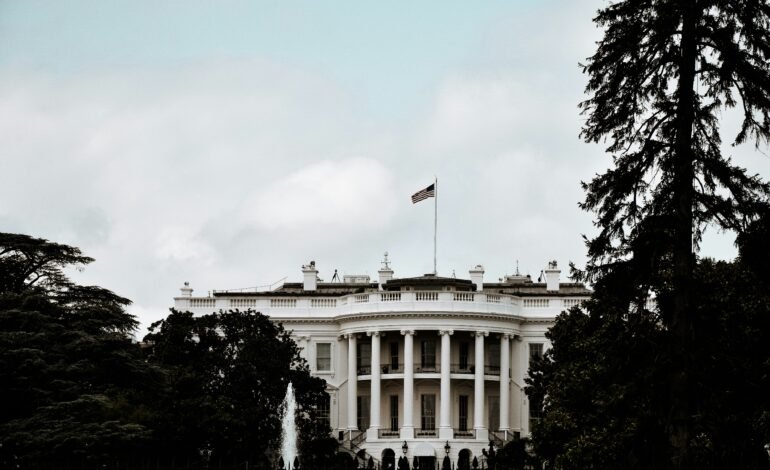Trump and Congress clash: risk of shutdown
The U.S. government faces an imminent shutdown due to the lack of agreement between the Trump White House and Democrats on funding.

Photo of Edoardo Cuoghi in Unsplash
Just a few hours before the end of the fiscal year, the United States is experiencing a latent institutional crisis: neither Congress nor the White House have reached an agreement on public financing, which puts at risk the closure of federal agencies or 'shutdown' and even an operational pause at the White House if the conflict is not addressed. President Donald Trump, who heads the executive branch, is facing a Democratic bloc that is conditioning its support for a government "rescue" bill on meeting certain public health demands.
The origin of the clash: a “clean bill” versus Democratic demands
Republicans are proposing a "clean" continuing resolution (CR) bill: extending funding for seven weeks until November 21, maintaining current spending levels without including additional provisions.
However, Democrats insist that this bill cannot be passed unless it includes the extension of Affordable Care Act (ACA) subsidies, a reversal of Medicaid cuts, and other provisions they consider essential to protecting access to healthcare.
The fundamental conflict is this: Democrats view the extension of health benefits as non-negotiable, while the White House and Republicans argue that including such requirements would turn the bill into a "cloaked omnibus," loaded with political conditions.
Trump: Failed meetings and mixed messages
A meeting was held at the White House on Monday, September 29, with Trump, Vice President JD Vance, and congressional leaders from both sides (Schumer, Jeffries, Thune, and Johnson). Efforts at compromise proved unsuccessful, and the Democrats left the meeting without an agreement.
Vance warned after the meeting that the government is "heading toward a shutdown" if Democrats don't budge. For his part, President Trump has said a shutdown is a real possibility and has rejected Democrats' demands, stating that they will bear the political consequences if they don't cooperate.
Trump also previously canceled a meeting with Schumer and Jeffries, arguing that their demands were "ridiculous" and that he saw no room for productive negotiation. This decision was perceived by Democrats as a deliberate attempt to pressure them to compromise.
Shutdown: Imminent consequences
If a funding bill is not approved by midnight on September 30, many federal agencies will have to suspend operations (for those functions deemed "non-essential"), and thousands of employees will be placed on furlough (without pay until funding is resumed).
In symbolic terms, although there is no talk of a "physical closure" of the White House as a building, the shutdown of the administrative apparatus—the inability to conduct normal government functions—would amount to an operational lockdown for many purposes. The legal and security departments maintain (internal) contingency plans to continue operating essentially.
He shutdown It will also bring considerable political costs for both sides. Republicans accuse Democrats of using the shutdown to advance their agenda, while Democrats accuse the executive branch of using the shutdown as a leverage to impose conditions without negotiation.
The role of financing and recent reforms
The conflict doesn't stem solely from the health dispute: the government, under the Trump administration, has already promoted budget cuts and rescinding allocations that have generated friction with traditionally less partisan sectors. For example, the Termination Act of 2025 The Rescissions Act, passed and signed by Trump, cut $7.9 billion from international assistance programs and $1.1 billion from funding for public broadcasting (PBS, NPR). In addition, the executive branch signed an order eliminating federal funding for the Corporation for Public Broadcasting (CPB), citing media bias.
These measures, seen by many as political rather than purely administrative decisions, exacerbate the perception that funding disputes are not merely technical, but deeply ideological.
Who can give in?
The political possibilities revolve around three scenarios:
- Democrats accept the "clean" project without health concessions: This would weaken their political position, as they would give in on one of their flagship issues.
- The Executive or the Republicans allow the inclusion of health subsidies in the financing project: They would lose their argument that this issue should not be conditioned on the continuity of the government.
- The impasse remains and the closure occurs (shutdown)Many agencies will remain inactive, federal workers will see their payrolls affected, and political pressure will fall on whoever is perceived as responsible for the failure.
The tension of the time limit
The clock is ticking, and there's no room for long, drawn-out negotiations. Congress needs to pass, and the president needs to sign, a bill before midnight Tuesday to avoid the shutdownSome observers expect an "emergency" compromise to emerge in the final moments.
For now, political tension, partisanship, and the role of financing are at the heart of this crisis, with the White House at the epicenter of the clash between two visions of government.
For more stories like this, follow More Latin.
Sources:
